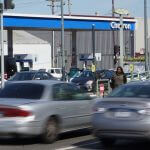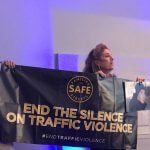A car-free Market Street: so far, it’s working
Last week, San Francisco made countless headlines when private vehicles were officially – and permanently – removed from Market Street.
For us at Walk San Francisco, this was an incredible step forward for the 500,000 people who walk on Market Street each day.
We are so proud to have been part of this historic victory, which countless people and nonprofit partners pushed for (and some for a very long time!).
At Walk SF, we see this as a turning point for San Francisco prioritizing safety and people on our streets. Already the conversation has turned to which San Francisco streets should be made car-free next.
But back to Market Street. The morning after Market went car-free, we gathered with almost 100 Walk SF members to experience the entire car-free stretch from Van Ness Avenue to the Ferry Building on foot. Here’s more about what we saw – and felt.
Calmer, quieter, and a lot safer
As we headed east on Market Street from Van Ness, it was easy to get a baseline for what a Market Street with cars feels like: eastbound traffic isn’t fully diverted until 10th Street.
After we crossed 10th Street, it was noticeable how much calmer and quieter Market Street quickly felt. With less traffic, the street space seemed to open up so you could better take in the people, streetcars, and buildings. Instead of the unpredictable chaos of cars on a city street, buses and bikes cruised by.
It was the intersections along Market Street where the safety benefits of going car-free were most obvious. For so long, Market Street has been one of the city’s most dangerous streets for pedestrians; five of San Francisco’s top ten most dangerous intersections are on Market.
But with private vehicles no longer allowed to turn on and off Market Street, it changed the entire dynamic at every intersection. Plus, SFMTA installed “quick build” improvements at intersections using paint and posts to shorten the crossing distance for pedestrians (this also narrows the lane so vehicles drive more slowly).
‘It’s working’
About a mile into our walk down Market Street, Walk SF’s executive director Jodie Medeiros turned to me. “It’s working,” she said with a huge grin. “It’s really working.”
SFMTA parking control officers were stationed at each cross street ensuring both that drivers heeded the restrictions and intersections were clear when it was time for pedestrians to cross.
Uber and Lyft also put geofencing in place on their apps so that pickups and dropoffs on Market are no longer allowed. And according to a security guard at a bank on Market Street, the geofencing is working. “Every day I stand here watching Uber and Lyft drivers stopping in crazy places and doing U-turns,” he told me. “But not today. I like it.”
Removing private vehicles from Market Street is just the beginning of what will be a long road. The first phase of construction of the Better Market Street project (from 5th to 8th Streets) won’t break ground until 2021.
Walk SF will continue to watchdog how Market Street is working, including how the city is enforcing the no-car ban and improving intersection designs that protect pedestrians on our “Main Street.”
Significant car-free spaces and reduced traffic downtown are a big part of how Oslo, Norway dramatically improved safety on its streets; the city had ZERO pedestrians and bicyclists fatalities in 2019 (Helsinki just reported zero pedestrian fatalities in 2019). So let’s build on the momentum from Market Street – and make this happen in San Francisco.
We are going to deliver Valentine’s to the officers enforcing a car-free Market Street on the morning of Friday, February 14 starting at 8:30AM. Want to join us? RSVP here.
Want to show your love for people-first streets? Make a special gift to Walk San Francisco.
Banner image by Kristen Gerencher, who wrote this fantastic article including our victory walk on Market Street.




